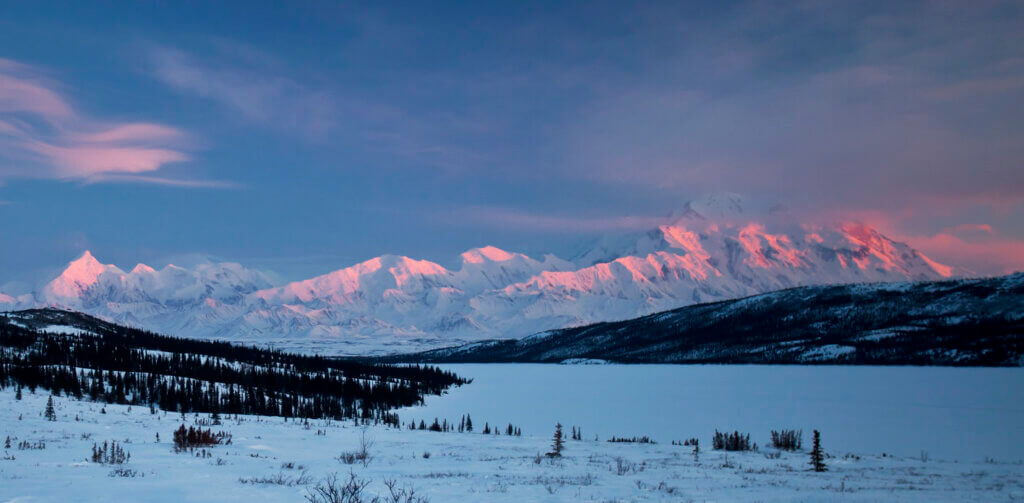Seeing Winter Through Rose-Colored Glasses
By Jennifer Newbold
Broadcast 12.21 & 12.24.2022

Evening alpenglow from Wonder Lake in Denali National Park. National Park Service photo by Jacob W. Frank, CC 2.0.
Listen:
It is that time of year again, when fall slowly fades into winter and daylight begins to wane. Many people warmly welcome the shorter days and longer nights, tucked inside and perhaps snuggled by a fire. Not so for me, who craves light like a bear craves huckleberries. The end to what we call Daylight Savings comes with no silver lining. But in my quest to find joy in each short winter day, the increased darkness of this season does come with a pink lining.
Alpenglow. Those fleeting moments of purple mountain majesty. That time of day when the snow-capped peaks seem almost ethereal as they are awash in violets, pinks, oranges, and reds. But what actually is it?
In meteorological terms alpenglow falls under “atmospheric optics.” Alpenglow is derived from the German word, “alpengluhen,” which literally means “alps glow.” Simply put, however, it is the natural phenomenon which occurs when mountain slopes are illuminated by the sun with a rosy glow as it rises or sets. What is it about that glow that is so special? From my perspective, it serves as a bright spot in an otherwise darkness-dominated day.
What causes the mountain peaks to display such shades of brilliance? That’s up for debate. The traditionally accepted cause of alpenglow is that it is created by indirect light. However, others insist it is caused by the sun’s direct rays hitting a surface.
Scientifically speaking, “At sunset, the atmosphere acts like a color filter, scattering blues and greens out of our view and leaving behind reds, oranges and yellows,” explains physics and engineering instructor Joanna Casey. Those in the indirect light camp theorize that when the sun dips just at or below the horizon, its light has to travel through a bunch of atmosphere—lots of dust particles, moisture, and aerosols—and in the process, the shorter blue and violet light wavelengths are scattered. This allows the light from the longer orange and red light waves at the end of the electromagnetic spectrum to move in, creating a blaze of color on the slopes that face the light. This idea rests on the notion that when the sun has set, there is no more direct light shining on the mountain and what we witness is refracted light.
Conversely, those who are in the direct light camp hypothesize that if you stand on a mountaintop blanketed in alpenglow, you will actually see the sun above the horizon, providing direct light. In other words, it may be simply a matter of your perspective. Regardless of which theory you subscribe to, we see the glow for the same reason. Because the sun sits lower in the sky, the sunlight must reach far through the atmosphere to touch the peaks and create the rosy, warm hue we enjoy.
Although alpenglow can occur in the summer or winter, it seems especially dramatic in the colder months, when light itself is in short supply, the landscape is barren, and a stark white canvas of snow—if we are in luck—lies waiting for Mother Nature’s paintbrush to magically splash warm light across the peaks for a few magical moments. More technically, the thickness of the atmosphere, and how much moisture or particles are in that atmosphere, can affect the vibrancy and intensity of the light. Moisture and pollution particles can block much of the sunlight. So, in dry or freezing climates where there is less moisture in the air, the colors are less diluted and the pinks and purples can really come alive.
For me, whichever musing is correct is certainly interesting to consider, but ultimately, the result is the same spectacular light show. For a light-seeker on an otherwise dark day, witnessing the mountains bathed in these longer waves of light feels like seeing winter through rose-colored glasses. And that is all I need.
Every week since 1991, Field Notes has inquired about Montana’s natural history. Field Notes are written by naturalists, students, and listeners about the puzzle-tree bark, eagle talons, woolly aphids, and giant puffballs of Western, Central and Southwestern Montana and aired weekly on Montana Public Radio.
Click here to read and listen to more Field Notes. Field Notes is available as a podcast! Subscribe wherever you listen to podcasts.
Interested in writing a Field Note? Contact Allison De Jong, Field Notes editor, at adejong [at] montananaturalist [dot] org or 406.327.0405.
Want to learn more about our programs as well as fun natural history facts and seasonal phenology? Sign up for our e-newsletter! You can also become a member and get discounts on our programs as well as free reciprocal admission to 300+ science centers in North America!












